Add a Child Node to the Relationship Graph
Learning Objectives
After completing this unit, you’ll be able to:
- Add a child node to an ARC relationship graph.
- Configure a child node.
- Customize an ARC relationship graph to meet the needs of the business.
Customize the B2B Graph Template
The B2B graph template is a great starting point for building an ARC graph. The nodes are preconfigured with display fields and record actions, but Matt can update them to match the ones requested by his users. He can even customize the node labels.
The subsidiaries node has a many-to-many relationship type that shows accounts that are related to a parent account.
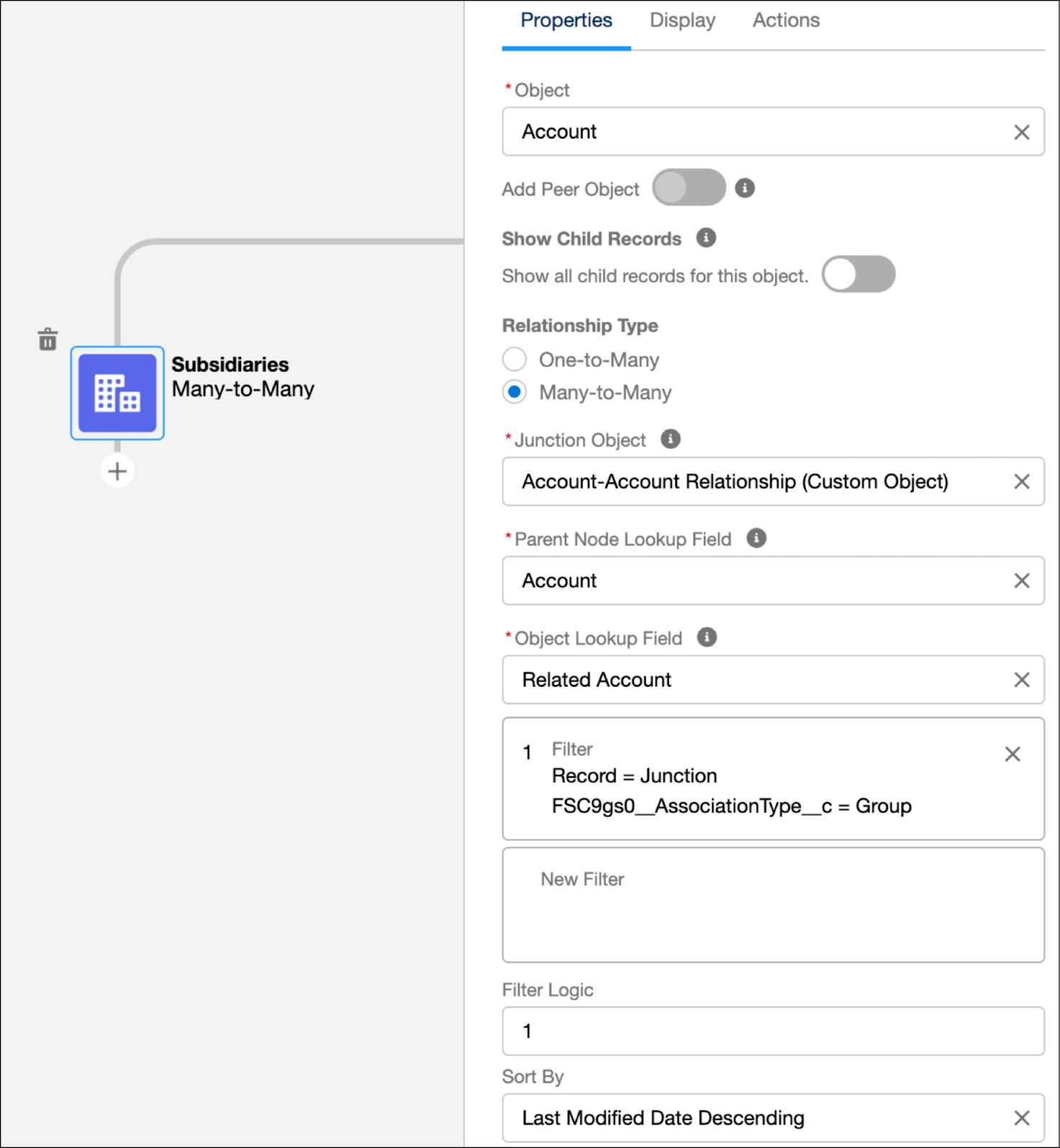
[Alt text: Customize subsidiaries node display: Properties tab.]
A many-to-many relationship allows each record of one object to be linked to multiple records from another object and vice versa. When modeling this type relationship, you use a junction object to connect the two objects you want to relate to each other.
On the subsidiaries node:
- The junction object of account-account relationship represents a relationship between two accounts, such as between a primary business like Buttercream Bakery and a franchise, such as Buttercream Bakery Downtown.
- The parent node lookup field is a field on the junction object that points to the parent node object.
- The object lookup field is a field on the junction object, which is account-account relationship, that points to the node’s object.
Follow along as Matt customizes the subsidiaries node on the B2B graph.
Use the Financial Services Cloud org you created earlier in this module.
- Open the Retail Banker Graph you created in the previous unit.
- Select the Subsidiaries node.
- On the Properties tab, remove the filter and save your changes.
- Click the Display tab.
- Under Card Information, customize the card fields for your users.
- Select Customize field labels.
- To customize the first field, click the X to remove Country, and select Parent Account and Account Name.
- Enter
Main POCin the Field Label text box.
- To customize the second field, click the X to remove Industry and select Billing Address.
- Enter
Addressin the Field Label text box.
- To update the last field, select Phone in the Show Field, and enter
Phone Numberfor the field label.
- Select Customize field labels.
- Click Save.
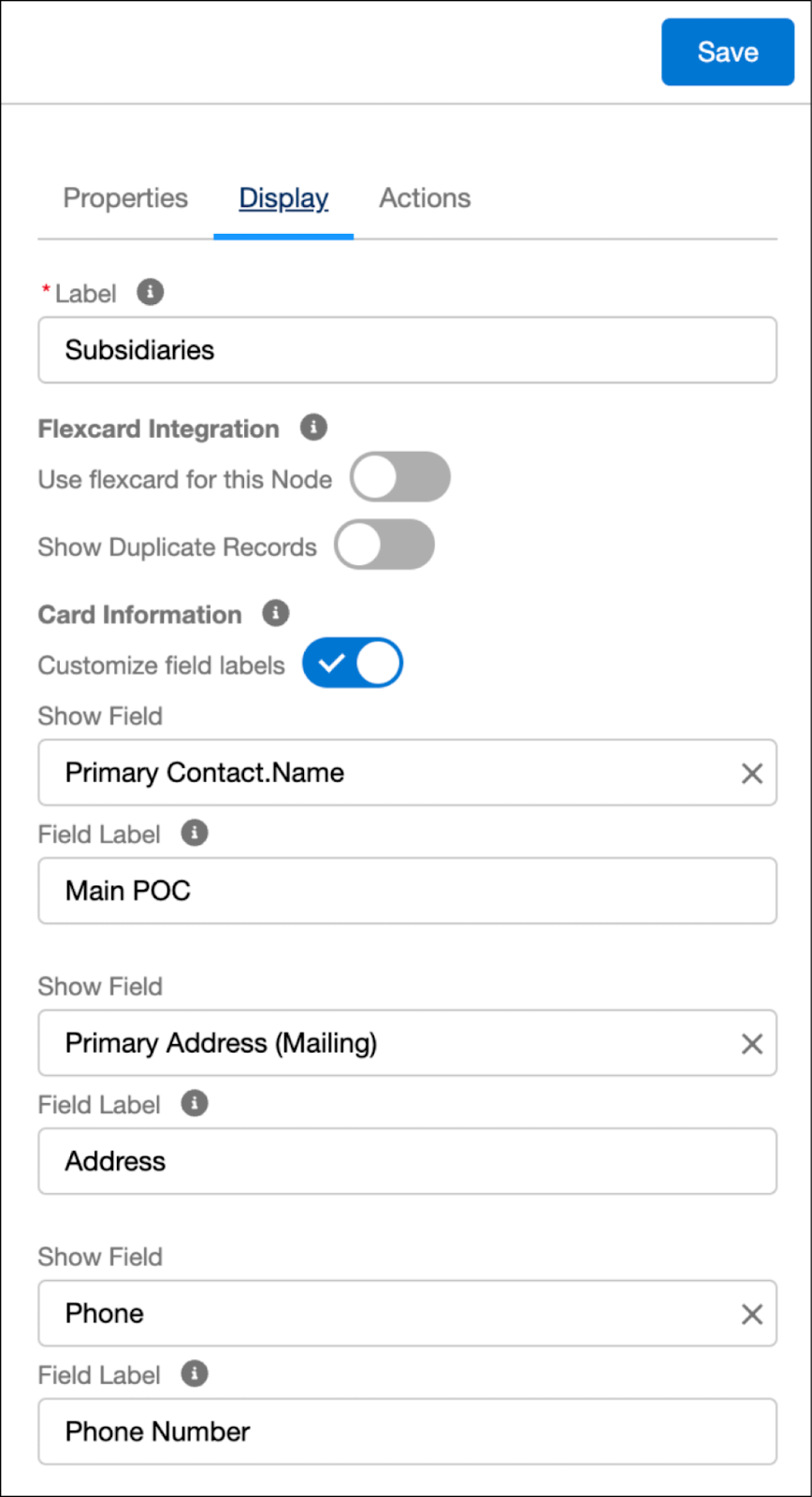
[Alt text: Customize subsidiaries node display: Display tab.]
Next, configure the Actions tab.
- Click the Actions tab.
- In Object Actions, confirm New is selected. This gives users quick access to add new subsidiaries.
- In Record Actions, for Action Label, enter
Record Actions.
- Confirm the Add Relation, Add Member, Edit, and Delete actions are shown. This gives users quick access to take the actions on a subsidiary.
- In Junctions Actions, for Action Label, enter
Related Record Actions.
- Confirm that the Edit and Delete actions are shown. This way, users have quick access to take these actions on related records.
- In Object Actions, confirm New is selected. This gives users quick access to add new subsidiaries.
- Click Save.

[Alt text: Customize subsidiaries node actions: Actions tab.]
Add an Employees Node to the Subsidiaries Node
Matt’s users need to see the employees at each subsidiary. Add an employees node to the subsidiaries node.
- Under the Subsidiaries node, click the plus icon.
- Complete the child node fields on the Properties tab:
- Select Object, Person Account.
- Select Many-to-Many relationship type.
- For the Junction Object, select Account Contact Relationship.
- For the Parent Node Lookup Field, select Account. The lookup field is a field from this node object (Person Account) that points to the parent node object (Account).
- For Object Lookup Field, select Contact.
- For Sort By, select Last Modified Date Descending to determine the sort order of the records on the node.
- Save your changes.
- Click the Display tab, and add these details:
- For Label, enter
Employees.
- Select Customize field labels.
- In Show Field, select Junction Object, then Roles. Note that Junction Object may be at the end of the list and not in alphabetical order.
- Enter
Rolein the Field Label text box.
- Select Email in Show Field.
- Enter
Emailin the Field Label text box.
- Select Title in Show Field.
- Enter
Titlein the Field Label text box.
- Save your changes.
- Click the Actions tab.
- In Object Actions, for Action, select New Relationship.
- In Record Actions, in the Action Label, enter
Record Actions.
- For Actions, select Edit and Delete.
- In Junction Actions, for Action Label, enter
Related Record Actions.
- For Actions, select Edit Relationship and Remove Relationship.
- Save your changes.
And that’s it! The subsidiaries node is customized to meet the needs of retail bankers.
Add a Child Node and Configure the Properties Tab
Matt moves on to customize the financial account node on the graph. His users need to view their clients’ financial account information. They want to see account type, account balance, primary owner, and household for each financial account. And they also need quick access to edit and create financial accounts.
Follow along to add and configure the financial account child node.
- Add child nodes to the relationship graph. Below the Account root node, click the plus icon.
- Complete the child node fields on the Properties tab:
- Select an Object, Financial Account (Custom Object).
- Select One-to-Many relationship type.
- For the Parent Node Lookup Field, select Primary Owner. The lookup field is a field from this node object (Financial Account) that points to the parent node object (Account).
- For Sort By, select Last Modified Date Descending to determine the sort order of the records on the node.
- Select an Object, Financial Account (Custom Object).
- Save your changes.
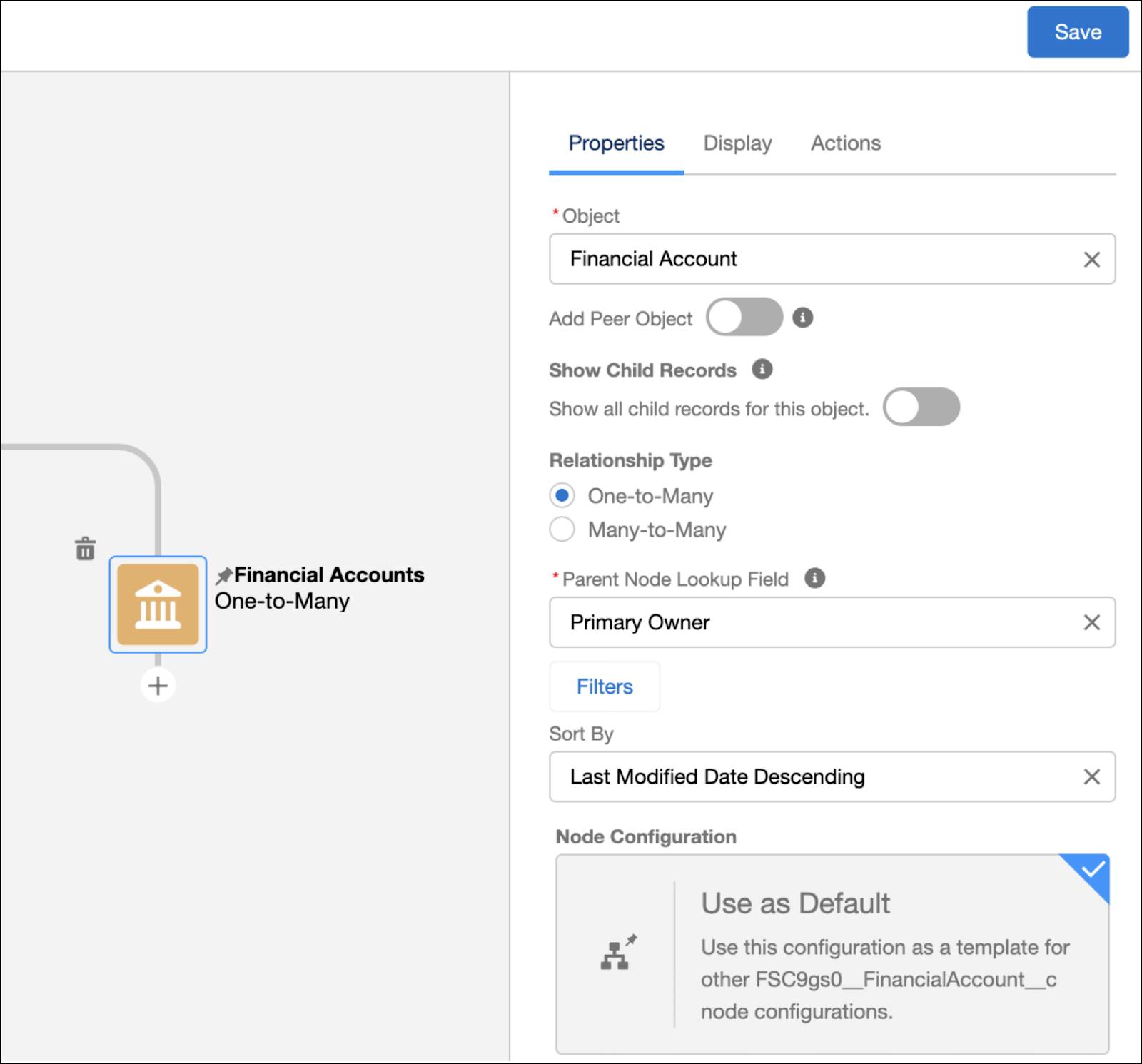
[Alt text: Customize financial account node properties: Financial Accounts node, Properties tab.]
Now it’s time to customize the display tab to show users relevant fields.
Configure the Child Node Display Tab
It’s time to customize the display tab to show the fields requested by users.
- Click the Display tab, and add these details:
- For Label, enter
Financial Accounts.
- Select Customize field labels.
- Select Balance in Show Field.
- Enter
Account Balancefor the field label.
- Select Record Type in Show Field.
- Enter
Account Typefor the field label.
- For the next field, select Primary Owner and Account Name,
- and use
Ownerfor the label.
- For the last field, select Household and Account Name, and enter
Related Householdfor the label.
- For Label, enter
- Save your changes to finish customizing the display tab.
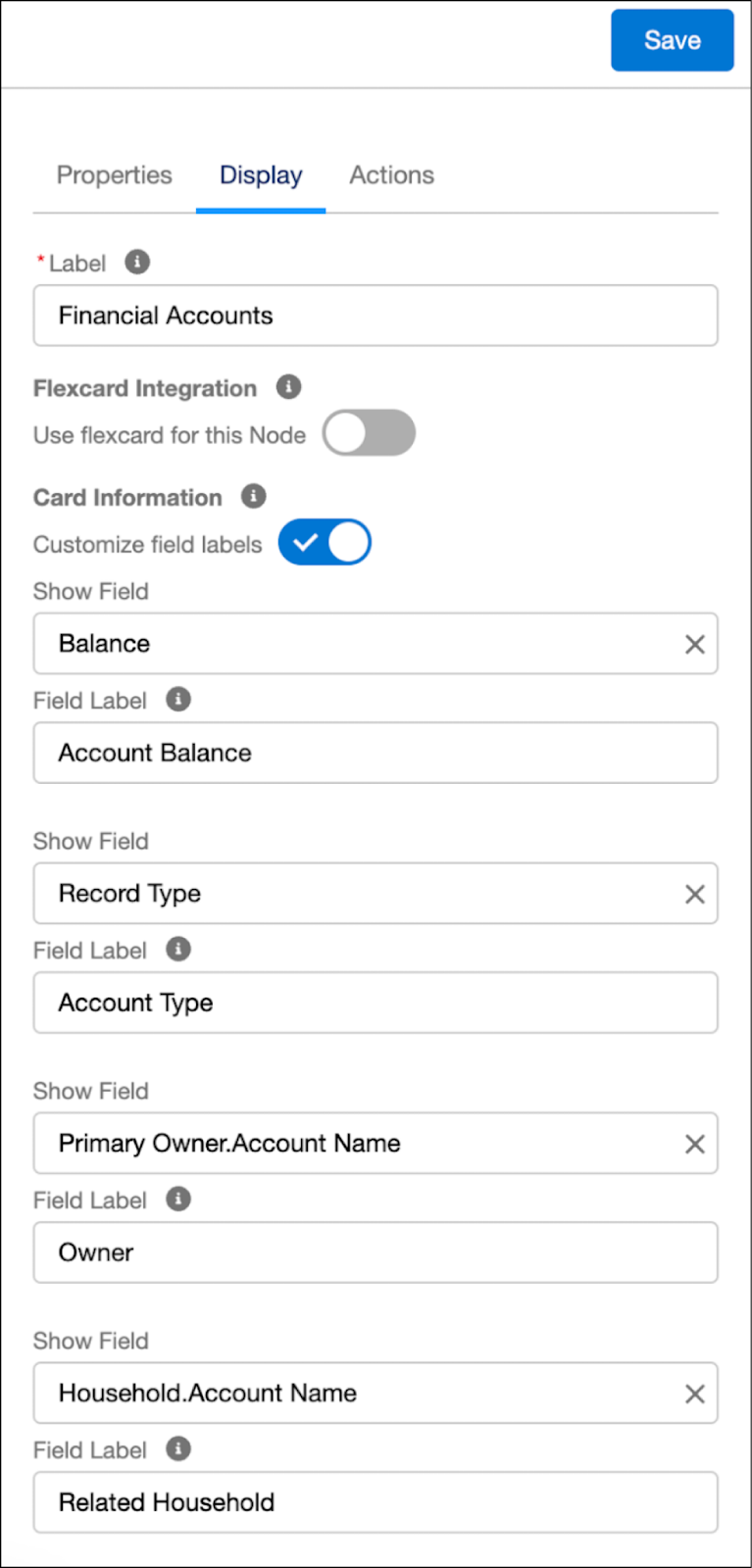
[Alt text: Customize financial account node display: Display tab.]
Configure the Child Node Actions Tab
Next, customize the actions tab to show the fields requested by users.
- Click the Actions tab.
- Under Object Actions, for Action, select New.
- Under Record Actions, for Action Label, enter
Record Actions.
- Add two actions as New Opportunity and Edit.
- Under Object Actions, for Action, select New.
- Save your changes.

[Alt text: Customize financial account node actions: Actions tab.]
Now Matt’s users can quickly review their client’s financial account information.
Add Other Child Nodes Based on the Plan
Matt follows the same steps to customize the employees and opportunities nodes that were included with the B2B template.
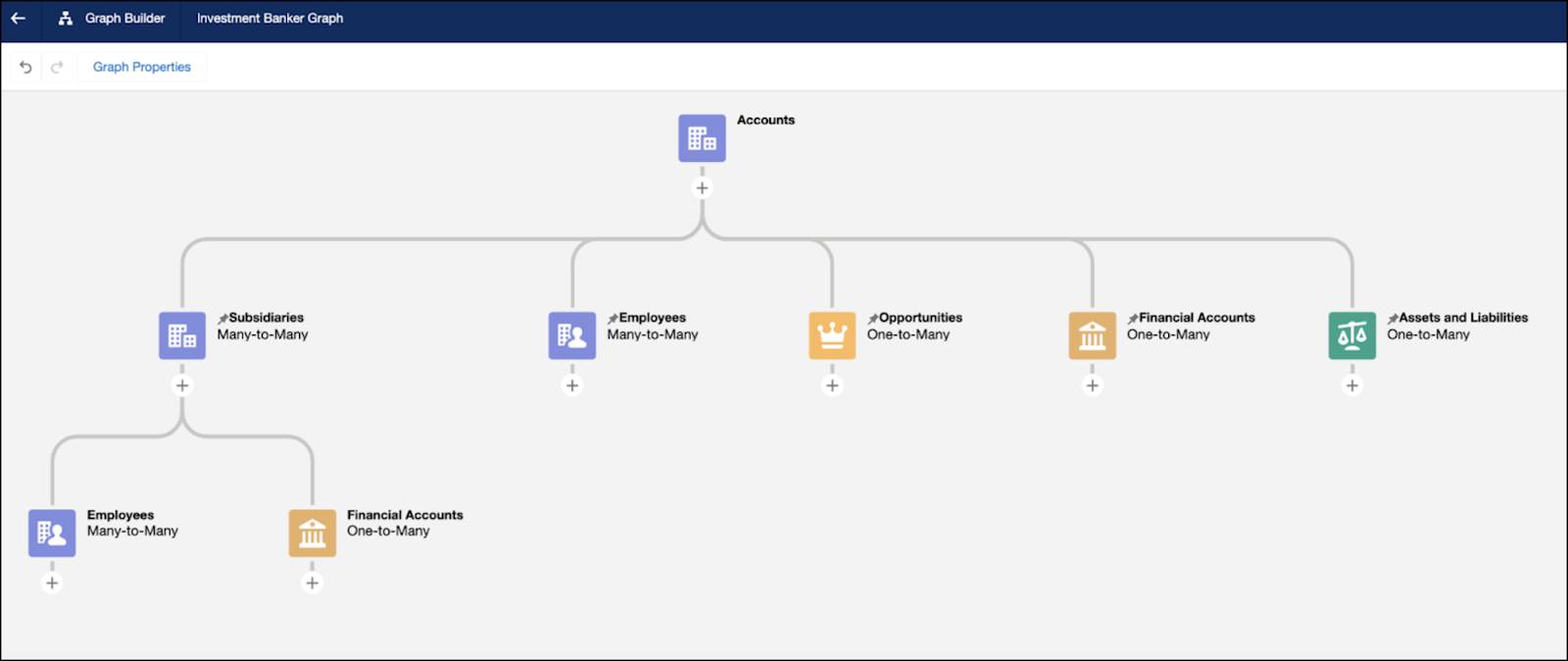
[Alt text: ARC graph: ARC graph nodes.]
Then he adds and customizes the financial accounts and assets and liabilities nodes. When he’s finished, the ARC graph contains all the information most relevant to his users.
Matt has updated the fields and labels on the ARC graph’s existing nodes and customized a new child node to show the client's financial accounts. He can’t wait to show the progress to Nora. Now, retail bankers can quickly determine their clients’ financial needs.